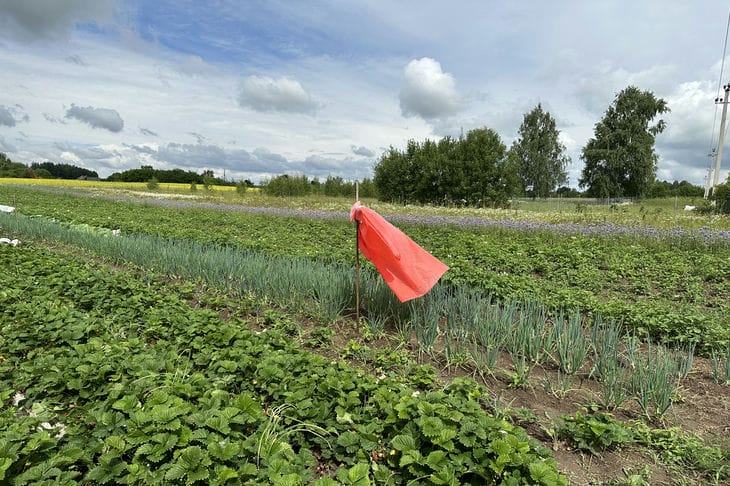How to turn clay soil into fertile black soil: tips for summer residents
Clay soils have extremely fine particles and can be thick and hard.
Although they are highly fertile, over centuries of agricultural use they become less fertile and produce poor yields.
One reason for this is that clay soils can be difficult to plant because they quickly stick together and form rubbers - hard lumps that prevent plant roots from getting enough nutrients and water.
This can slow down vegetation growth and also increase the risk of drought because water cannot penetrate the soil as effectively as in sandier soils.
Clay soils also typically have higher levels of hydrogen and lower levels of available nutrients compared to other soil types, such as black soil.

As a result, plant roots may not receive enough nutrients to grow and develop effectively.
This problem can be solved by introducing various methods of converting clay soil into fertile black soil, such as the introduction of organic fertilizers, the use of microbiological preparations and the use of tillage methods.
Overview of soil types and main characteristics of clay soil
There are several types of soils that differ in physical, chemical and biological characteristics.
They include sandy soils, clay soils, sandy loam soils, peat soils, chernozems and others.
Clay soils are characterized by a fine texture, high clay and silica content, and low sand and organic matter content.
Due to the small clay particles, the structure of clay soils is very dense, as a result of which they do not allow the free movement of air and water.
Clay soils are capable of retaining water and minerals for long periods of time and are therefore used as agricultural material.
However, clay soils also have several disadvantages.
For example, clay becomes stagnant and does not allow nutrients to reach plant roots well, which can lead to poor growth and low yields.
Such soils may also be subject to erosion and other forms of degradation, which can weaken their ability to supply nutrients.
Due to the high density and low permeability of clay, the expansion of the root system of plants on such soils can be difficult. Crops can grow more slowly on clay soils than on other types of soil.
Reasons why clay soil is less fertile than black soil
Clay soils have several characteristics that can reduce their fertility compared to other soil types, such as black soils:
Reduced permeability
Clay soils have a very dense structure and small pores, making them poorly permeable to water. This can lead to stagnant water and reduced nutrient availability for plants.
Need to improve the structure
Clay soils can quickly become sticky and rubbery, which can make it difficult for plant roots to penetrate and nutrients to become available.
Low organic matter content
Clay soils have low levels of organic matter, which is essential for healthy plant growth and development.
The need to maintain the correct pH
Clay soils tend to have a slightly lower pH, which can cause some nutrients to leach out and reduce the availability of nutrients to plants.
Preservation of mineral salts
Clay soils are good at retaining mineral salts, which can be toxic to plants if they remain in the soil in large quantities.
These factors taken together can reduce the fertility of clay soils and make them less fertile than chernozems.
However, with the right soil improvement techniques, clay soils can become more fertile and productive.
Steps to Turn Clay Soil into Fertile Black Soil
Turning clay soil into fertile black soil may take some effort and time, but the following steps can help you achieve this goal.
Soil condition assessment
It is important to conduct a soil analysis to determine its pH, organic matter, nutrient content, and other parameters. This will help determine what problems need to be addressed.
Working with pH
If your clay soil does not have a high enough pH, you can add lime to it. Adding lime will help achieve the optimal pH for growing most plants.
If the pH is too high, acids or other agents can be added to lower it.
Improving soil structure
By adding sand, straw, humus and other organic matter, you can improve the structure of clay soil. This will help it retain moisture and gases better, as well as improve overall fertility.
Adding Nutrients
Clay soils tend to store minerals. Adding organic fertilizer will help replenish nutrients and support healthy plant growth.
Using mulch
Mulching will help retain moisture, prevent soil erosion, and improve soil structure.
Regular application of organic fertilizers
Regular application of organic fertilizers will help maintain soil fertility over a long period of time.
Regular watering
Regular watering of clay soils will help maintain optimal moisture levels, which will unlock the soil's nutritional potential and improve plant health.
Crop rotation
Crop rotation will help maintain healthy soil, preventing plant diseases and degrading salts.
Although converting clay soil into fertile black soil may take time and resources, one can always seek professional advice to better understand how to increase the fertility of clay soil.
Earlier we talked about hilling vegetables .
